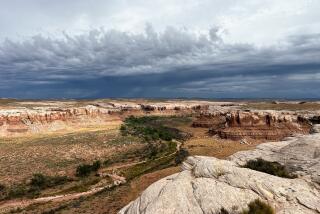Pioneers’ Historic Registry at Risk
CITY OF ROCKS, Idaho — More than a century ago, wagon-train travelers scrawled names, dates, even “Wife Wanted” in axle grease on the granite pinnacles lining this popular stopover on the trail to California’s gold fields.
“There are thousands of names here,” pioneer Richard Augustus Keen wrote in an 1852 journal entry. “I registered mine on a large rock.”
Much of the historic graffiti is preserved in the National Park Service’s City of Rocks National Reserve 200 miles southeast of Boise.
But a sign reading “Private Property No Trespassing” sits in front of Register Rock, the towering gray monolith that contains the best-preserved inscriptions. And a sagging red-and-white “For Sale” sign in the sagebrush has been getting much of the attention in the federal park lately.
After five years of negotiations, the Park Service says it may be close to reaching a deal to buy the iconic fixture of western expansion from the Idaho rancher who owns the rock and a rutted section of the original California wagon trail.
William Loughmiller says that if the Park Service can’t meet his price, he’ll try to use the land as a recreational vehicle campground -- even though it is completely enclosed within the reserve. “I don’t want to be the guy with the bulldozer, but I had to do something to get them to come to the table,” he said.
Loughmiller bought the land from another rancher with the expectation that the Park Service and state of Idaho would trade him for livestock grazing rights on land outside the reserve, he said.
“That’s what they promised me, but when they didn’t follow through, they forced me into the development game to recoup my losses,” he said.
Recently, the Park Service took the unusual step of offering to buy Loughmiller’s 290 acres for more than its estimated fair market value.
“Congress expects us to pay very close to what an appraisal would show it’s worth,” said Rick Wagner, chief of the Park Service’s lands resources program center in Seattle. “We are having to come up with ways to get him more money than what an appraisal would show, but they are within the bounds of law and policy.”
The Park Service was able to boost its undisclosed purchase offer with a $25,000 contribution from the Oregon-California Trails Assn., a 3,000-member organization of overland trail buffs headquartered in Independence, Mo.
Register Rock is one of several examples along the old wagon-train routes where historic sites are sometimes threatened by the very development they helped usher in, said Dave Welch, the association’s national preservation officer.
“Most of the time, it’s not the Wal-Marts and the oil companies that wipe trail resources out,” he said. “It’s more unintentional, just someone not even knowing a trail is there and grading their farm field or expanding a city.”
From 1841 to 1869, historians estimate, the westward trails carried more than 500,000 settlers to the new frontier, forever changing the character of the land.
In 1992, Congress designated 14,000 miles of the four major routes -- the Oregon, California, Pony Express and Mormon Pioneer trails -- as national historic paths to be preserved and promoted. The designated trails run through 13 states.
The law doesn’t prevent private landowners from bulldozing the remnants of the migration routes, however. In cases where construction is proposed on sections of trail crossing federally owned land, the National Park Service and Bureau of Land Management try to work with developers to mitigate impact to the routes and scenic vistas.
But when projects are built on trail sections on private land, “oftentimes we find out too late to have a chance at making a difference,” said Jere Krakow, superintendent of the National Trails System in Santa Fe, N.M.
Register Rock is an unusual case because it is private property in the heart of a federal park. The Park Service has acquired about half the 8,000 acres of private holdings within the park since the reserve was established in 1988, but Loughmiller’s land is considered the most critical to preserving the historical integrity of the area.
“It would be irresponsible if the Park Service did not try to acquire this important piece of the story,” said Wallace Keck, superintendent of the reserve.
As a result of local zoning codes for land in the reserve, Loughmiller’s proposals for developing the land have been stalled and a series of appraisals has not come up with a price tag comparable to the value of land being sold outside the reserve.
“Mr. Loughmiller has been patient as we’ve tried to create a financial environment that still shows we are getting a good value for the taxpayers’ dollar,” Wagner said.
Welch said the trail association’s members were willing to pony up the $25,000 addition to the purchase price because they considered Register Rock and the section of California trail Loughmiller owned part of a vanishing national heritage.
“I love to go to these places, sit there by myself and ponder who went by here,” Welch said. “But there are fewer and fewer of these places left.”
More to Read
Sign up for The Wild
We’ll help you find the best places to hike, bike and run, as well as the perfect silent spots for meditation and yoga.
You may occasionally receive promotional content from the Los Angeles Times.






